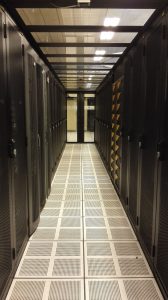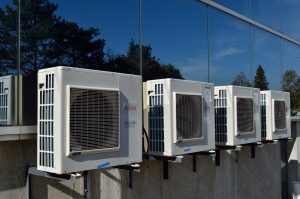
Knowledge Base / News / IT & Data Centers
Data centers are the lifeblood of many organizations. Whether their primary focus is supporting the organization’s data and infrastructure or providing services to clients, any downtime they suffer will have a hugely negative impact.
It’s important to have a clear view of all the factors that can potentially lead to data center downtime. Outside and inside forces are often monitored with security features such as firewalls, network intrusion detection, keycard entry, alarm systems, and IP camera surveillance. With so much focus on cyber security, many organizations often overlook the fact that 30% of their downtime will be caused by environment factors that they are not monitoring.
Room Alert was designed to help organizations large and small monitor those environment factors that can cause downtime and equipment or facilities damage. Installing Room Alert monitors and sensors actively helps organizations spot data center issues before they lead to costly downtime. If you are not currently monitoring any of the following environment factors, it’s critical that you consider Room Alert for your data center or computer room.
 Power loss is one of the most critical factors that can lead to data center downtime. While most data centers have UPS batteries to protect servers in the event of main power loss or fluctuation, they often are in place to provide time to gracefully power servers down, not supply continuous power in the event the main feed is lost.
Power loss is one of the most critical factors that can lead to data center downtime. While most data centers have UPS batteries to protect servers in the event of main power loss or fluctuation, they often are in place to provide time to gracefully power servers down, not supply continuous power in the event the main feed is lost.
Backup generators are often installed in larger data centers and colocation facilities. Often, smaller organizations that maintain a small local data center or server room may not be able to afford a generator; when they do have one installed, it may need to be manually engaged.
Monitoring power at the server and rack level with Active Power w/Temperature Sensors lets you know if power to your servers and appliances is lost (and you can even monitor for rising temperatures at the back the servers, which can indicate potential upcoming hardware or disk failure). Installing Power Sensors or Mini UPS & Power Sensors can help notify you when main power sources are lost. Newer PDUs in racks and cabinets sometimes have power or temperature monitoring built in, however if your servers are located in a third-party data center, receiving notification from your own monitors may mean the difference between a graceful shutdown and complete hard drive failure.
High temperatures can quickly lead to data center downtime, and in many instances are caused by HVAC failure. In fact, the most common reason a new customer contacts us is due to downtime caused by high temperatures when their air conditioning has failed. By that point in time, hardware and data are almost always lost, and recovery times are long and costly. Power loss can also be a cause for high temperatures, since the HVAC likely turns off when power is lost, but computers and servers continue running and generating heat on UPS power.
Installing Room Alert and additional temperature sensors will allow you to monitor temperature in multiple locations within your data center or server room. If temperatures begin to rise, instant alerts will let you know that you are potentially on your way to a major problem. Being able to proactively address a failing HVAC will allow you to prevent downtime and damaged hardware, saving you thousands of dollars in damages, downtime, and lost productivity.
“I wish I had known about Room Alert BEFORE we went down” is unfortunately a phrase we hear far too often from new customers. Rising temperatures could be an early indication that a HVAC needs service, or is starting to fail. It could also be caused by increased heat load following new equipment installations usage increases. Don’t let rising temperatures, cause downtime in your data center. If you are colocating in an outside data center, installing Room Alert in your rack or cabinet will remove your reliance on your provider’s monitoring, and give you instant alerts if temperatures become too high.
 Humidity is sometimes an after thought when it comes to environment factors to monitor, however it can be just as damaging as high temperatures. Too much humidity in your data center, and condensation will form on sensitive electric devices. Too little humidity can lead to the risk of static discharge, which can be just as damaging to hard drives and circuit boards.
Humidity is sometimes an after thought when it comes to environment factors to monitor, however it can be just as damaging as high temperatures. Too much humidity in your data center, and condensation will form on sensitive electric devices. Too little humidity can lead to the risk of static discharge, which can be just as damaging to hard drives and circuit boards.
Monitoring for humidity fluctuation with our Digital Temp & Humidity Sensor helps you keep an eye on both temperature and humidity throughout your data center and will help alert you when factors exceed the thresholds you determine. Our RoomAlert.com Account also has ASHRAE recommendations built right into the monitoring platform so you can be sure that your facility stays within accepted guidelines and maintains maximum uptime.
Nothing can bring down a data center faster than a water leak. Whether it’s extreme weather, a leaking roof, a clogged pipe, a construction accident, or any other number of unexpected issues, water coming into contact with servers and network appliances will bring your organization down in an instant.
Far too many organizations don’t think they need to monitor for “flood” conditions, thinking that their proximity (or lack thereof) to larger bodies of water keeps them safe from water damage. We’ve stressed the fact that organizations are ten times more likely to suffer from water damage than they are from fire damage; everyone has smoke and fire alarms, however the percentage of organizations who proactively monitor for water leaks is shockingly small.
Installing Flood Sensors with Cable can easily monitor multiple areas in your data center to alert you to the presence of water as soon as it’s detected. This inexpensive and reliable solution will potentially save your data center from outright disaster if a pipe bursts, or an accident causes water or sewer backup that enters your facility.
Data center downtime isn’t a matter of “if”, it’s a matter of when. Over 60% of data centers say downtime was due to environment issues at least 1 time in the last 12 months. Don’t become another statistic! If your data center’s environment isn’t proactively monitored by Room Alert, now is the time to contact us for a customized environment monitoring solution. Don’t delay! Always remember: proactive monitoring is better than disaster recovery.

You may find Windows Command Prompt at the following path:
To run Windows Command Prompt as an administrator:
| Current S models | Current E models |
|---|---|
| Room Alert 32S | Room Alert 32E |
| Room Alert 12S | Room Alert 12E |
| Room Alert 3S | Room Alert 4E |
| Room Alert 3E | |
| S models | E & W models |
|---|---|
| Room Alert 32S | Room Alert 32E |
| Room Alert 12S | Room Alert 12E |
| Room Alert 3S | Room Alert 4E |
| Room Alert 3E | |
| Room Alert 3W |
| Model |
|---|
| Room Alert MAX |
| Room Alert 32S |
| Room Alert 12S |
| Room Alert 3S |
| Room Alert 32E/W |
| Room Alert 12E |
| Room Alert 4E |
| Room Alert 3E |
| Room Alert 3 Wi-Fi |